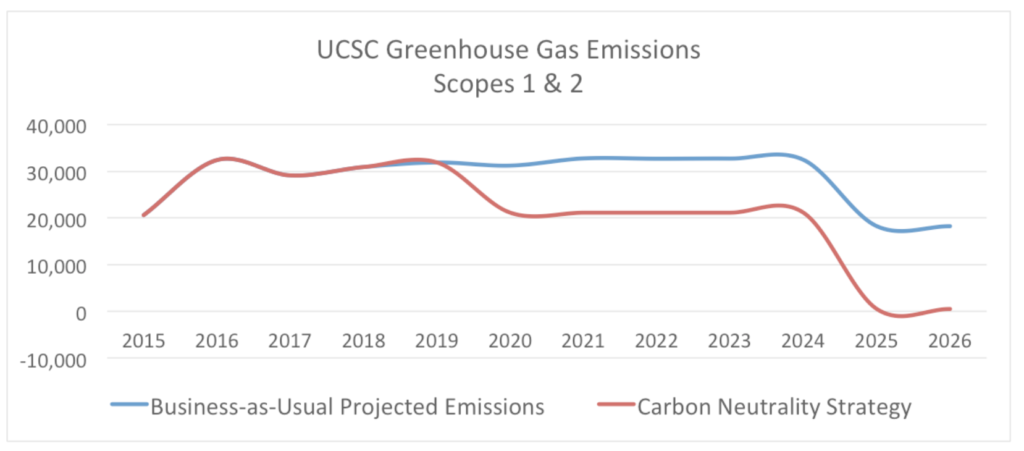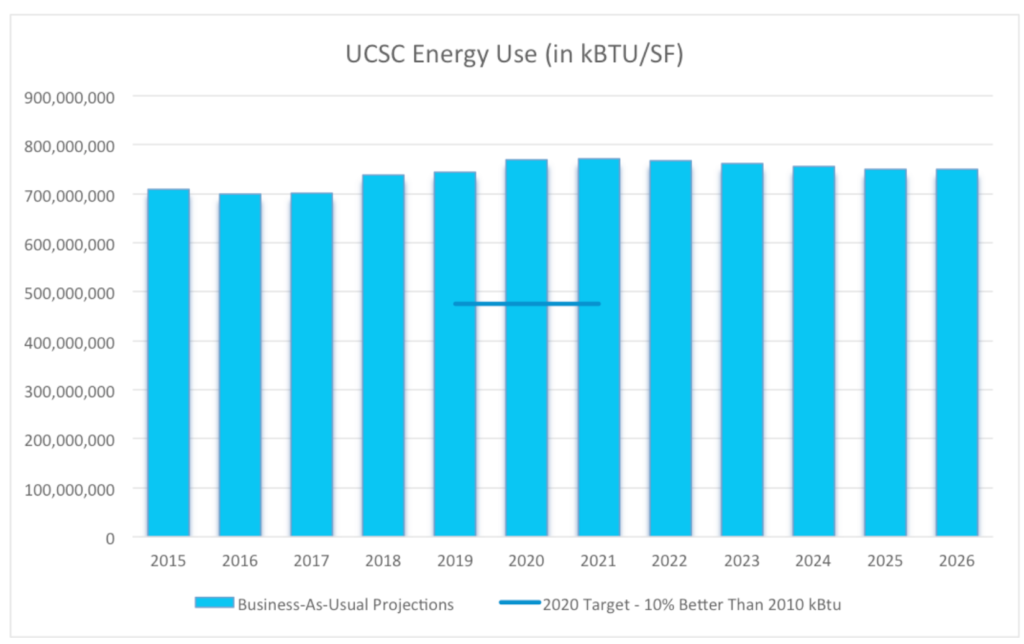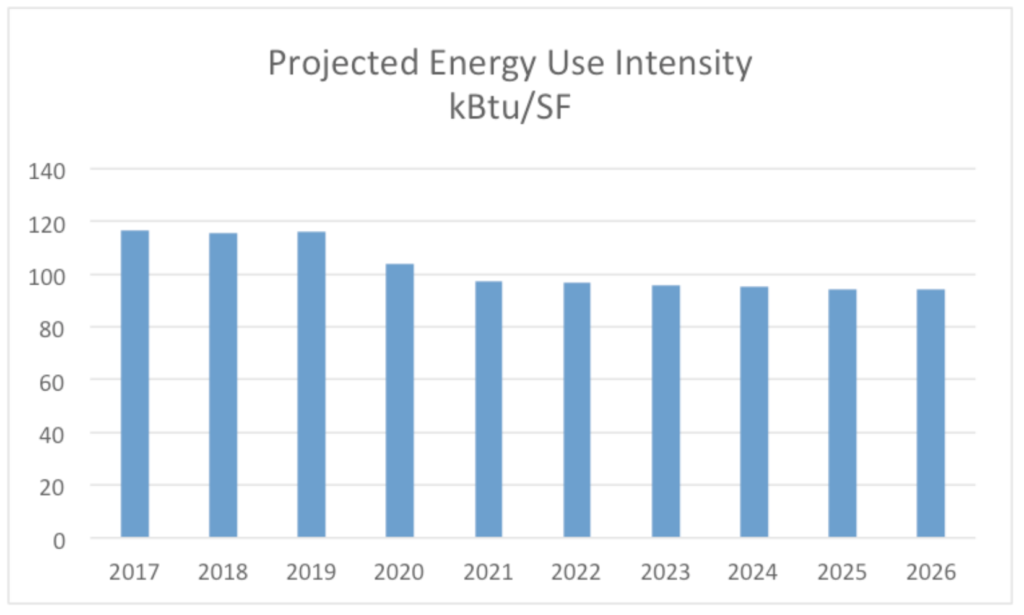
XXARCHIVE: Campus Sustainability Plan 2017-18 – TESTING 2019
LEARNING & CULTURE
 Learning and Culture identifies ways to connect social justice and environmental sustainability to the University’s research, teaching, and public service mission and into the campus culture. Several key considerations framed the development of the goals, strategies and actions for this topic. The first was a noted deficiency in previous campus Sustainability Plans, which identified technical and operational goals for the campus, and included very few targets to address issues related to justice and/or inclusion. The second consideration was changing student demographics at UC Santa Cruz and the need to frame and express sustainability in a way that reflects diverse lived experiences in order to improve student success and retention. The final driver was an increased effort across the UC system to engage students, staff and faculty in sustainability and climate change learning and action through the Carbon Neutrality Initiative. The goals and strategies under this topic provide mechanisms for engaging students, staff, faculty and the Santa Cruz community in sustainability through research, curricular and co-curricular efforts, outreach, education and collaboration; identify opportunities for integrating prosperity, equity, and fairness into our campus’ business and operations; and strategies to encourage the use of the campus as a living laboratory for academic research on sustainability and justice issues.
Learning and Culture identifies ways to connect social justice and environmental sustainability to the University’s research, teaching, and public service mission and into the campus culture. Several key considerations framed the development of the goals, strategies and actions for this topic. The first was a noted deficiency in previous campus Sustainability Plans, which identified technical and operational goals for the campus, and included very few targets to address issues related to justice and/or inclusion. The second consideration was changing student demographics at UC Santa Cruz and the need to frame and express sustainability in a way that reflects diverse lived experiences in order to improve student success and retention. The final driver was an increased effort across the UC system to engage students, staff and faculty in sustainability and climate change learning and action through the Carbon Neutrality Initiative. The goals and strategies under this topic provide mechanisms for engaging students, staff, faculty and the Santa Cruz community in sustainability through research, curricular and co-curricular efforts, outreach, education and collaboration; identify opportunities for integrating prosperity, equity, and fairness into our campus’ business and operations; and strategies to encourage the use of the campus as a living laboratory for academic research on sustainability and justice issues.
GOAL 1:
Create and sustain a campus climate and culture that values inclusive sustainability.
STRATEGY 1.1:
Continually measure and assess the degree to which students from various backgrounds feel included in sustainability.
ACTION 1.1.A:
Biannually distribute a campuswide inclusive sustainability survey to assess student experience.
Collaborator(s): People of Color Sustainability Collective
ACTION 1.1.B & 4.4.C (NEW in 2019): Host focus groups, as well as analyze and disseminate results from the 2019 campuswide inclusive sustainability survey to assess student experience.
STRATEGY 1.2:
Promote the principle that sustainability cannot exist without social justice.
ACTION 1.2.A:
Highlight and support People of Color Sustainability Collective’s efforts to convene campuswide conversations that include and reflect diverse lived experiences.
Collaborator(s): People of Color Sustainability Collective
STRATEGY 1.3:
Make existing sustainability programs more inclusive and culturally resonant.
ACTION 1.3.A:
Increase the number of applications from underserved, under resourced campus groups in sustainability grant opportunities.
Collaborator(s): Carbon Fund, Sustainability Office
STRATEGY 1.4:
Encourage participation of staff and faculty in inclusive sustainability educational opportunities.
ACTION 1.4.D:
Provide staff and faculty education on sustainability and inclusion through the Sustainability Certificate Program.
Collaborator(s): Sustainability Office
STRATEGY 1.5:
Train staff and faculty on effective mentorship approaches that support student leadership.
ACTION 1.5.A:
Develop resources and workshops for staff and faculty on effectively supporting students, including underrepresented students.
Collaborator(s): Office of Diversity, Equity, & Inclusion
GOAL 2:
Support inclusive sustainability in the local and broader community so that community members may thrive.
STRATEGY 2.1:
Convene a sustained dialog with students, staff, faculty, and community members to share information, knowledge and resources about community health.
ACTION 2.1.A:
Develop a year-long public event series to explore issues of affordability, mobility and health and food security as they pertain to inclusive sustainability.
STRATEGY 2.2:
Leverage the intellectual capabilities of the campus to solve sustainability problems using interdisciplinary, integrated approaches and identify opportunities to help members of the local community thrive.
ACTION 2.2.A:
Develop a year-long public event series to explore issues of affordability, mobility and health and food security as they pertain to inclusive sustainability.
STRATEGY 2.3:
Strengthen partnerships with local and regional communities and organizations that are already leading the charge in sustainability and social justice.
ACTION 2.3.A:
Develop a year-long public event series to explore issues of affordability, mobility and health and food security as they pertain to inclusive sustainability.
Collaborator(s): Colleges 9 & 10
GOAL 3:
Support student leadership efforts that strengthen a culture of inclusive sustainability.
STRATEGY 3.1:
Incorporate inclusive sustainability into the new student and Welcome Week experience.
ACTION 3.1.A:
Establish a working group to create a plan for student education and engagement, particularly focusing on incoming first-year, new transfer and international students.
Collaborator(s): Sustainability Office
STRATEGY 3.2:
Increase access to internship opportunities that allow students to demonstrate leadership in inclusive sustainability.
ACTION 3.2.A:
Provide opportunities for students to take a leadership role in implementing actions from the Campus Sustainability Plan through internships for academic credit and paid positions.
Collaborator(s): Sustainability Office
STRATEGY 3.3:
Support student leadership in inclusive sustainability by training staff and faculty on effective mentorship approaches.
ACTION 3.3.A & 1.5.a:
Develop resources and workshops for staff and faculty on effectively support students, including underrepresented students.
Collaborator(s): Office of Diversity, Equity & Inclusion
STRATEGY 3.4:
Develop institutional structures that support student leadership in inclusive sustainability-related decision making.
ACTION 3.4.A:
Ensure students, especially those traditionally underrepresented, are included in campus governance structures responsible for the implementation of the Campus Sustainability Plan.
Collaborator(s): Sustainability Office
GOAL 4:
Develop new and expand existing curricular educational experiences around inclusive sustainability.
STRATEGY 4.1:
Measure and assess the degree to which sustainability and climate change are included in the curriculum.
ACTION 4.1.A:
Conduct and promote an annual audit of UC Santa Cruz courses to identify those that include sustainability and climate change.
Collaborator(s): Sustainability Office
STRATEGY 4.2:
Undertake integrated research that examines the evolving meanings and experiences of sustainability.
ACTION 4.2.A:
Identify opportunities to encourage inclusive sustainability research opportunities through existing programs like the Koret Scholarship.
Collaborator(s): Undergraduate Education
ACTION 4.2.B:
Conduct a campuswide survey addressing the understood meanings of inclusive sustainability.
Collaborator(s): Colleges 9/10, People of Color Sustainability Collective
STRATEGY 4.3:
Facilitate innovative and interdisciplinary curricula and pedagogy around inclusive sustainability.
ACTION 4.3.A:
Convene a colloquium series within the Sustainability Faculty Group to highlight and transcend disciplinary approaches to sustainability topics.
Collaborator(s): Sustainability Office, Colleges 9/10, Rachel Carson College, Sustainability Faculty Group.
STRATEGY 4.4:
Ensure that all undergraduates acquire basic literacy in inclusive sustainability.
ACTION 4.4.A & 4.2.b:
Conduct a campuswide survey addressing the understood meanings of inclusive sustainability.
Collaborator(s): Colleges 9/10, People of Color Sustainability Collective
ACTION 4.4.B & 3.1A:
Create a plan for student engagement, particularly focusing on incoming first-year, new transfer and international students.
Collaborator(s): Sustainability Office
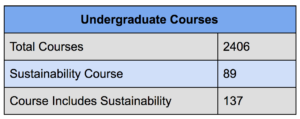

The course inventory includes all courses offered at least once between the three-year period of summer, 2014 and spring, 2017. Each offering of a course was counted as an individual course. Courses that were excluded from the course inventory include extension courses, travel study courses offered by other institutions, courses transferred for credit from other institutions, as well as independent study and independent research courses.
MATERIALS MANAGEMENT & FOOD SYSTEMS
Return to the Index
 Materials Management & Food Systems encompasses the purchase, use, and disposal or recycling of goods, as well as growing, consuming, and composting of food. These issues are interdependent: the campus waste stream is largely composed of materials and food that were procured or grown by the campus. In addition to sustainability challenges related to the procurement of materials or food and how it is disposed of or repurposed, each of these topics also have social justice implications, such as the distribution of university spending to local and diverse vendors; the labor conditions for people who grow the food our campus eats; and the environmental degradation that can occur in communities where products are recycled or sent to landfill.
Materials Management & Food Systems encompasses the purchase, use, and disposal or recycling of goods, as well as growing, consuming, and composting of food. These issues are interdependent: the campus waste stream is largely composed of materials and food that were procured or grown by the campus. In addition to sustainability challenges related to the procurement of materials or food and how it is disposed of or repurposed, each of these topics also have social justice implications, such as the distribution of university spending to local and diverse vendors; the labor conditions for people who grow the food our campus eats; and the environmental degradation that can occur in communities where products are recycled or sent to landfill.
GOAL 1:
Increase both Environmentally Preferred Product purchases and Real Food purchases by 5% until 2022.
STRATEGY 1.1:
Engage suppliers to develop strategies that promote sustainable and equitable procurement practices within the supply chain, and measure those suppliers to agreed standards.
ACTION 1.1.A:
Identify 10 additional commodities and/or suppliers annually to track and increase sustainable and equitable practices.
Collaborator(s): Procurement Services
STRATEGY 1.2:
Identify current food purchases that can be replaced with Real Food purchases.
ACTION 1.2.A:
Implement the Real Food Challenge qualifying products as previously identified by Real Food Challenge Interns and UC Santa Cruz Dining.
Collaborator(s): Dining, Food Systems Working Group, Center for Agroecology & Sustainable Food Systems
Funding Source: Real Food Challenge intern hosted by Food Systems Working Group & Dining
STRATEGY 1.3:
Make it easier for CruzBuy users to purchase Environmentally Preferred Products (EPP).
ACTION 1.3.A:
Explore functionality and possibilities for increased visibility and use of EPP favorites list.
Collaborator(s): Procurement Services
STRATEGY 1.4:
Standardize effective sustainable and equitable procurement education and training, particularly for incoming students and new staff and faculty.
ACTION 1.4.A:
Contribute educational materials regarding sustainable and equitable procurement to New Employee Orientation and the new student experience and Welcome Week.
Collaborator(s): Procurement Services, Provost’s Sustainability Internship Program, Staff Human Resources
STRATEGY 1.5/2.5:
Advance the single-use bottled water ban.
ACTION 1.5.A/2.5.A:
Address barriers that event hosts face in switching from single use bottled water to more sustainable options.
Collaborator(s): Take Back the Tap
GOAL 2:
Achieve and maintain the UC Office of the President Sustainable Practices Policy goal of Zero Waste.
STRATEGY 2.1:
Improve operational infrastructure to increase waste diversion.
ACTION 2.1.A:
Complete a compost/recycling collection and infrastructure rollout study that considers options for streamlining the waste stream across all collection areas.
Collaborator(s): Physical Plant
Funding Source: Cost savings from Grounds and Resource Recovery based on 2017 annual recharge rate financial viability assessment
STRATEGY 2.2:
Complete the Resource Recovery Yard, including on-site composting program rollout.
ACTION 2.2.A:
Identify and apply for grant funding for the Resource Recovery Yard equipment, facilities, and construction.
Collaborator(s): Physical Planning, Development & Operations (PPDO) Sustainability Office
Funding Source: Staff time
STRATEGY 2.3:
Increase the percentage of equipment and items sold or repurposed from Surplus, rather than discarded.
ACTION 2.3.A:
Create new mechanisms for campus users to find and share used equipment.
Collaborator(s): Surplus, Provost’s Sustainability Internship Program
Funding Source: Provost’s Sustainability intern hosted by Surplus
STRATEGY 2.4:
Develop effective waste reduction and Zero Waste education and training for students, staff and faculty.
ACTION 2.4.A:
Research best practices in trainings that currently exist on campus, other UCs, and local agencies.
Collaborator(s): Provost’s Sustainability Internship Program, Sustainability Office Zero Waste Team
Funding Source: Student internship project
STRATEGY 1.5 / 2.5:
Advance the single-use bottled water ban.
ACTION 1.5.A / 2.5.A:
Address identified barriers that student event hosts face in switching from single use bottled water to more sustainable options.
Collaborator(s): Take Back the Tap
Funding Source: Student internship project, possible Campus Sustainability Council grant
GOAL 3:
Improve food security and access for the campus community, and reduce student food insecurity by 50%.
STRATEGY 3.1:
Develop educational programs and opportunities that support food security efforts.
ACTION 3.1.A:
Establish a working group to create materials and messaging to engage underrepresented students with food security and basic needs resources, including Produce Pop-Up stand, Slug Support Pantry, Swipes for Slugs, and a Food Access and Basic Needs web site.
Collaborator(s): Global Food Initiative Food Access and Basic Needs Working Group
Funding Source: Global Food Initiative, student intern/fellow project
STRATEGY 3.2:
Improve institutional structures, food preparation, and food production opportunities to support food security of the campus community.
ACTION 3.2.A:
Create a food security resources map detailing existing food preparation and food storage spaces, as well as Electronic Benefits Transfer (EBT), Women, Infants and Children (WIC) and other food access and distribution locations.
Collaborator(s): Global Food Initiative Food Access and Basic Needs Working Group
Funding Source: Global Food Initiative, student intern/fellow project
STRATEGY 3.3:
Align regional community food security partners and resources to benefit the campus community.
ACTION 3.3.A:
Host CalFresh enrollment workshops and invite Supplemental Nutrition Assistance Program (SNAP-ED) community funder partners to assist and promote CalFresh on campus.
Collaborator(s): Global Food Initiative Food Access and Basic Needs Working Group
Funding Source: Global Food Initiative, student intern/fellow project
NATURAL ENVIRONMENT & INFRASTRUCTURE
Return to the Index
 Natural Environment & Infrastructure highlights the interrelated nature of campus lands and physical infrastructure and explores synergies related to the operational topics of Transportation, Land & Habitat Stewardship, Watershed & Stormwater, and Water Conservation. Drivers include human use of lands, including facility development and potential enrollment growth, campus infrastructural upgrade needs, the scarcity of local water resources and supply, as well as parking and traffic constraints. A number of key topics emerged within Natural Environment & Infrastructure: to utilize the gift of the exquisite diversity of campus natural lands and built environment to benefit the UC’s primary mission of teaching and research through student experiential learning opportunities; to intentionally working to build a culture of stewardship on campus; and to ensure the preservation and conservation of campus’ natural resources through creatively working to meet and exceed UC Office of the President goals.
Natural Environment & Infrastructure highlights the interrelated nature of campus lands and physical infrastructure and explores synergies related to the operational topics of Transportation, Land & Habitat Stewardship, Watershed & Stormwater, and Water Conservation. Drivers include human use of lands, including facility development and potential enrollment growth, campus infrastructural upgrade needs, the scarcity of local water resources and supply, as well as parking and traffic constraints. A number of key topics emerged within Natural Environment & Infrastructure: to utilize the gift of the exquisite diversity of campus natural lands and built environment to benefit the UC’s primary mission of teaching and research through student experiential learning opportunities; to intentionally working to build a culture of stewardship on campus; and to ensure the preservation and conservation of campus’ natural resources through creatively working to meet and exceed UC Office of the President goals.
GOAL 1:
Conduct an assessment to address intersectional campus infrastructure needs that include and support sustainable transportation systems, reduce water consumption, manage stormwater, and steward campus natural and cultivated lands.
STRATEGY 1.1:
Develop a framework to define, identify and prioritize built and natural infrastructure improvement projects.
ACTION 1.1A:
Establish a working group to address intersectional campus infrastructure gaps and needs.
Collaborator(s): Physical Planning, Development & Operations (PPDO) with contributors from across campus;
Funding source: Staff time.
STRATEGY 1.2:
Measure effects of human activity on campus lands, watersheds, and infrastructure.
ACTION 1.2.A & 5.1.A:
Conduct an analysis to establish a baseline to quantify human impact on campus natural and cultivated lands.
Collaborator(s): Environmental Studies (grad student and Senior Thesis course)
Funding source: Chancellor’s Graduate Internship Program (CGIP).
GOAL 2:
Meet the UC Office of the President Sustainable Practices Policy goal to reduce potable water usage by 36% by weighted campus user by 2025 from a 2005-08 baseline.
STRATEGY 2.1:
Increase the use of non-potable water on campus.
ACTION 2.1.A:
Launch an update to the Campus Water Reuse Study.
Collaborator(s): Physical Planning, Development & Operations (PPDO)
ACTION 2.1.B:
Develop and implement an evaluation and monitoring program to assess potential impacts from groundwater use from the existing well as an irrigation source.
Collaborator(s): Physical Planning, Development & Operations (PPDO)
Funding source: One time funding from campus, with ongoing support.
STRATEGY 2.2:
Reduce potable water use through technological innovations and physical improvements.
ACTION 2.2.A:
Compile and update a centralized list of proposed water infrastructure and fixture improvements along with their relative cost and water saving potential.
Collaborator(s): Physical Planning, Development & Operations (PPDO), Sustainability Office
Funding source: Staff time
STRATEGY 2.3:
Improve communication about water management, use, and conservation to the campus and local community.
ACTION 2.3.A:
Increase the adoption and utilization of the Beacon leak detection software among building managers through trainings and one-on-one consultations.
Collaborator(s): Physical Planning, Development & Operations (PPDO)
Funding source: Staff project
STRATEGY 2.4:
Identify new sources of funding for both potable water reduction and non-potable sourced development projects.
ACTION 2.4.A:
Develop a life-cycle cost based funding model to account for potable water rate increases.
Collaborator(s): Energy Services/Planning & Budget
Funding source: Utility savings. Lifecycle cost analysis.
GOAL 3:
Reduce commute travel mode impacts relative to a 2017 baseline by: reducing Scope 3 commuter greenhouse gas emissions 10% by 2022; reducing commute vehicle miles travelled (VMT) 5% by 2022; and reducing per capita parking demand 10% by 2022.
STRATEGY 3.1:
Increase transit ridership to/from campus by 10%.
ACTION 3.1.A:
Collaborate with Santa Cruz Metro Transit District (SCMTD) to increase capacity and frequency of service on UC Santa Cruz routes, including incorporation of articulated buses and new routes to UC Santa Cruz satellite locations.
Collaborator(s): Transportation & Parking Services (TAPS)
Funding source: Student Transit Fees
STRATEGY 3.2:
Develop an outreach strategy to promote sustainable transportation culture and prioritize human-powered on-campus travel at UC Santa Cruz.
ACTION 3.2.A:
Pilot sustainable transportation peer-to-peer outreach activities.
STRATEGY 3.3:
Explore creative funding options for sustainable transportation programs that reduce vehicle trips and address social justice implications of the current fee structure being heavily supported by student fees.
ACTION 3.3.A:
Study the viability of centrally funded sustainable transportation access or Transportation Demand Management (TDM) fee.
Collaborator(s): Transportation & Parking Services (TAPS) and Advisory Committee on Transportation & Parking (ACCTP)
Funding source: Effort to secure reliable, sustainable funding beyond current fees and fares and external grants through parking permit fees, TDM program fares, student fees, or departmental central funds assessment to cover the transportation infrastructure and programs costs.
STRATEGY 3.4:
Increase electric vehicle charging infrastructure and programs to achieve a 4.5% mix of zero-emission vehicles for personal commute by 2025.
ACTION 3.4.A:
Develop a comprehensive plan for inclusion of electric vehicle charging station that integrates with current and planned parking development.
Collaborator(s): Transportation & Parking Services (TAPS), Physical Planning, Development & Operations (PPDO)
Funding source and potential cost: Partial external grants; partial parking permit fees; some funded through development project requirements. Assessment underway; TAPS- funded infrastructure costs will vary by project.
ACTION 3.4.B:
Partner with other UCs, electric vehicle dealers and charger equipment companies, utility companies, and pursue grants to increase incentives for UC affiliates to purchase or lease electric vehicles, for electric vehicle charging equipment and other infrastructure.
Collaborator(s): Transportation & Parking Services (TAPS)
Funding source and potential cost: Partnerships with vendors; partial external grants; partial parking permit fees; some funded through development project requirements at no costs to UC for personal vehicle incentives.
GOAL 4:
Involve all students in experiential learning in the natural and built environments that comprise the campus as a living laboratory.
STRATEGY 4.1:
Develop a strategic framework for the explicit and broad use of campus natural lands for experiential learning across the curriculum by end of Fiscal Year 2019.
ACTION 4.1.A:
Draft a white paper documenting past and current work in the field of experiential learning on campus lands.
Collaborator(s): ENVS faculty, Campus Natural Reserve, and Natural Reserve staff
STRATEGY 4.2:
Utilize current STARS reporting inventory on experiential learning as a baseline of student involvement and campus engagement opportunities.
ACTION 4.2.A:
Identify avenues to improve information collection processes of experiential learning opportunities on campus.
Collaborator(s): Sustainability Office and Natural Reserves, units that offer experiential learning opportunities
STRATEGY 4.3:
Communicate to students and campus entities the meaning and the value of participating in and hosting an experiential learning opportunity.
ACTION 4.3.A:
Utilize current outreach materials like the Sustainability Office’s Living Lab Map and develop new materials to promote experiential learning opportunities.
Collaborator(s): Natural Reserves, Sustainability Office
GOAL 5:
Elevate and sustain a campus climate, culture, and brand that values stewardship.
STRATEGY 5.1:
Develop a campus natural lands management, stewardship, and invasive species plan by end of Fiscal Year 2020.
ACTION 5.1.A & 1.2.A:
Conduct an analysis to establish a baseline to quantify human impact on campus natural and cultivated lands.
Collaborator(s): Natural Reserves, Physical Planning, Development & Operations (PPDO)
STRATEGY 5.2:
Develop effective stewardship education for students, staff, and faculty.
ACTION 5.2.A:
Establish a working group to develop a communications campaign to promote stewardship practices of campus natural and cultivated lands.
Collaborator(s): Natural Reserves
ACTION 5.2.B:
Contribute educational materials regarding stewardship to New Employee Orientation and the new student experience and Welcome Week.
Collaborator(s): Natural Reserves, Provost’s Sustainability Internship Program, Staff Human Resources
Funding Source: Student internship and/or staff project
STRATEGY 5.3:
Increase formal and informal engagement opportunities with stewardship topics and nature-based learning by utilizing campus natural lands.
ACTION 5.3.A:
Inventory current offerings of formal and informal engagement opportunities and establish a baseline by which future progress can be measured.
Collaborator(s): Natural Reserves
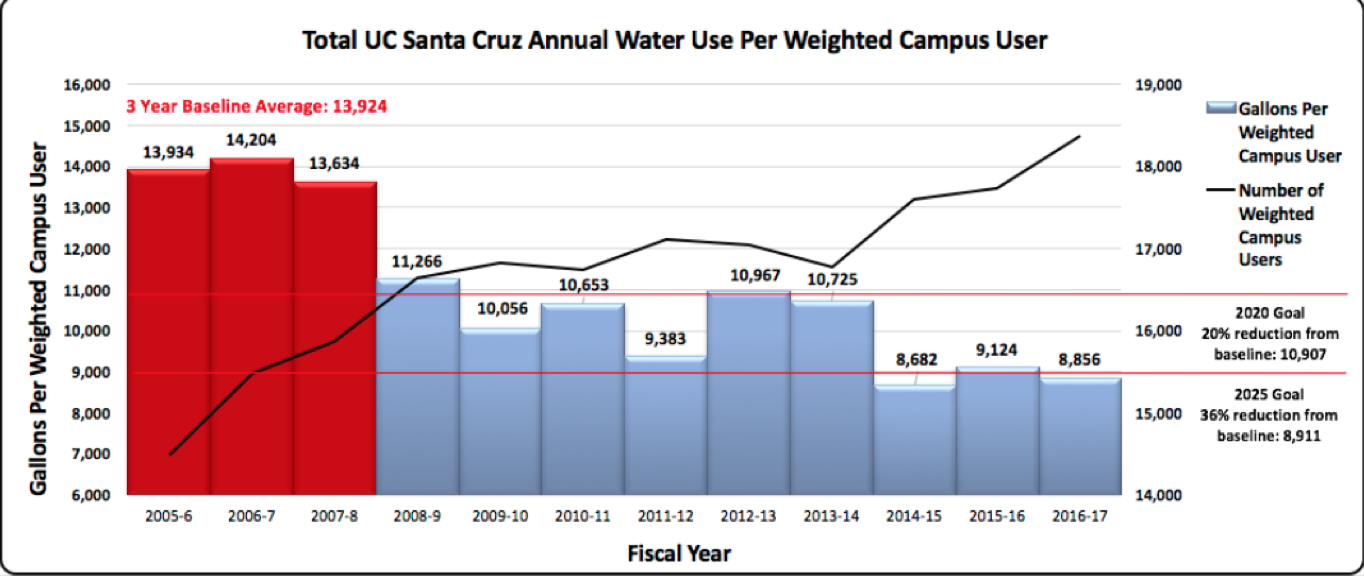
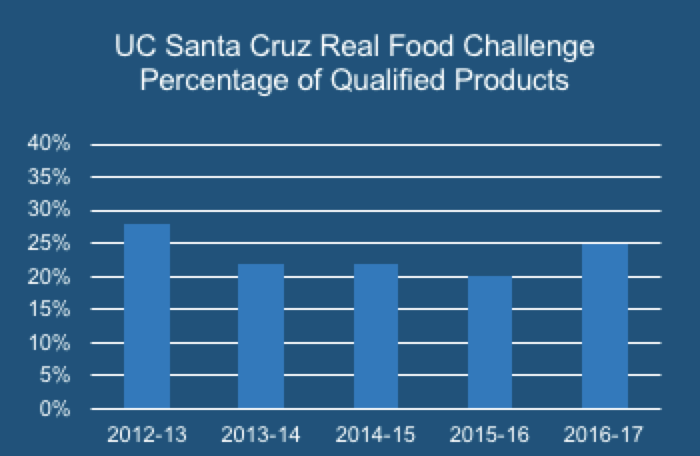
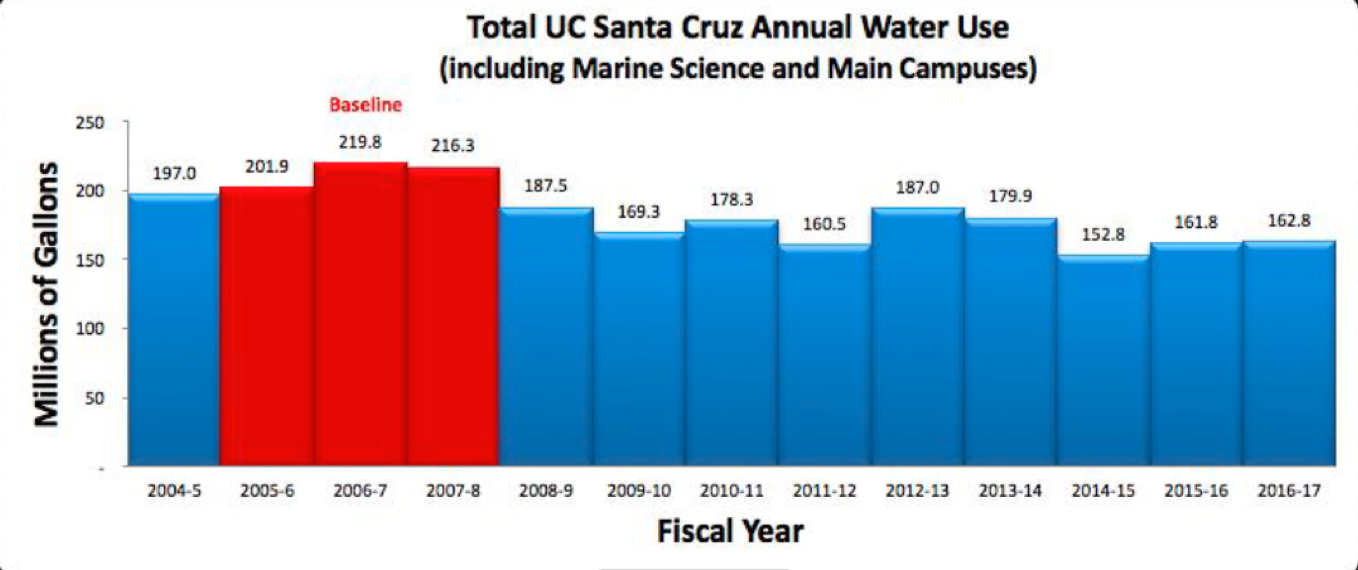
CLIMATE & ENERGY
Return to the Index
 Climate & Energy addresses the Carbon Neutrality Initiative, a systemwide challenge issued by President Napolitano for all campuses to achieve carbon neutrality by 2025 for their onsite sources of combustion, such as cogeneration and boilers, purchased electricity and the campus vehicle fleet. The campus recently completed an extensive planning process to develop a carbon neutrality strategy that resulted in a report called the Climate and Energy Strategy (CES). The Climate & Energy Committee considered the recommendations from the CES report and incorporated them into the CSP strategies and actions, and also considered behavior change, education and student experiential learning. “Carbon Neutral Operations” looks beyond electricity and fuel use to consider carbon impacts of existing and planned operations. “Energy Efficiency in New & Existing Buildings” seeks to reduce energy use and emissions associated with existing and planned labs, administrative buildings, housing, and other campus facilities. Renewable Energy is mainly focused on solar, as solar is one of the most cost-effective and reliable technologies available to support carbon-free energy generation. The Campus Fleet mainly focuses on light-duty vehicles as this is where the most efficiency can be gained. Energy Conservation is focused on energy savings that can be achieved through education and behavior change. While these goals are definitely ambitious, we hope the strategies and actions provide tangible next steps. Read on to see what you think, and how you might support our move towards carbon neutrality!
Climate & Energy addresses the Carbon Neutrality Initiative, a systemwide challenge issued by President Napolitano for all campuses to achieve carbon neutrality by 2025 for their onsite sources of combustion, such as cogeneration and boilers, purchased electricity and the campus vehicle fleet. The campus recently completed an extensive planning process to develop a carbon neutrality strategy that resulted in a report called the Climate and Energy Strategy (CES). The Climate & Energy Committee considered the recommendations from the CES report and incorporated them into the CSP strategies and actions, and also considered behavior change, education and student experiential learning. “Carbon Neutral Operations” looks beyond electricity and fuel use to consider carbon impacts of existing and planned operations. “Energy Efficiency in New & Existing Buildings” seeks to reduce energy use and emissions associated with existing and planned labs, administrative buildings, housing, and other campus facilities. Renewable Energy is mainly focused on solar, as solar is one of the most cost-effective and reliable technologies available to support carbon-free energy generation. The Campus Fleet mainly focuses on light-duty vehicles as this is where the most efficiency can be gained. Energy Conservation is focused on energy savings that can be achieved through education and behavior change. While these goals are definitely ambitious, we hope the strategies and actions provide tangible next steps. Read on to see what you think, and how you might support our move towards carbon neutrality!
GOAL 1:
Support the UC Office of the President Sustainable Practices Policy goal of achieving carbon neutrality for scopes 1 & 2 emissions by 2025.
STRATEGY 1.1:
Reduce greenhouse gas emissions from stationary sources of combustion, campus-owned vehicles and purchased electricity through energy efficiency and conservation, onsite renewables, and other actions and technologies.
ACTION 1.1.A:
Develop a Sustainable Fleet Implementation Plan to procure zero emission vehicles or hybrid vehicles for at least 50% of all new light-duty vehicle acquisitions.
Collaborator(s): Fleet Services
ACTION 1.1.B:
Develop a phased plan to install up to 4MW of solar PV on the main campus, 2300 Delaware and Coastal Science Campus.
Collaborator(s): Sustainability Office with assistance from campus engineers
STRATEGY 1.2:
Identify and address gaps in information, training, technologies and funding to support carbon neutrality goal.
ACTION 1.2.A:
Create a working group to explore internal carbon accounting model to incentivize low-carbon design for new capital projects and energy efficiency within existing operations, distinguishing between state-funded and auxiliary units.
Collaborator(s): Sustainability Office with assistance from Campus Architect, Project Managers and Capital Planners
STRATEGY 1.3:
Develop a strategy to achieve UC Office of the President Sustainable Practices Policy interim goal of reducing scope 1 & 2 emissions to 1990 levels by 2020.
GOAL 2:
Achieve net zero emissions for all new capital projects.
STRATEGY 2.1:
For all major capital projects, achieve at least the UC Office of the President Sustainable Practices Policy “stretch” energy use intensity (EUI) targets and strive for 50% better than baseline design.
ACTION 2.1.A:
Refine and adopt Energy Use Intensity “stretch targets” as outlined in the UC Sustainable Practices Policy.
Collaborator(s): Sustainability Office will lead with assistance from Physical Planning and Construction and Capital Planning
STRATEGY 2.2:
Develop and implement a net zero energy policy for capital projects that provides different avenues to mitigate emissions and incorporates net zero ready building requirements.
ACTION 2.2.A:
Conduct a feasibility study to explore fiscal and operational impacts of adopting an all-electric policy for all new construction across campus.
Collaborator(s): Sustainability Office will lead with assistance from campus engineers
STRATEGY 2.3:
Continue to achieve LEED Silver and strive for LEED Gold (V4) for new buildings and, for labs, meet at least the prerequisites of the Laboratories for the 21st Century (Labs21).
ACTION 2.3.A:
Within the preliminary design phase of capital projects over $750,000, improve the process for capturing life-cycle building costs, including capital and operating costs, and evaluate design alternatives that support greater energy efficiency.
Collaborator(s): Physical Planning and Construction will lead with assistance from Capital Planning and Sustainability Office
GOAL 3:
Improve the energy efficiency of campus buildings by 10% below a 2010-2012 baseline (in kbtu/sf).
STRATEGY 3.1:
Implement the 90+ energy efficiency and renewable energy projects identified in the UC Santa Cruz Climate & Energy Strategy report recommendations.
ACTION 3.1.A:
Establish a team of staff dedicated to implementation of energy efficiency projects, which will be paid for through annual energy savings.
Collaborator(s): Energy Services Department, Physical Planning, Development & Operations (PPDO)
Funding Source: Capital projects and labor will be financed through the Strategic Energy Partnership low-interest bond funds and annual debt service will be paid for through avoided costs from energy savings. Project expenses will be recharged to the SEP project.
STRATEGY 3.2:
Reduce energy use from plug loads through procurement policies and behavior change.
ACTION 3.2.A:
Develop and implement an Energy Star, or related, requirement for all equipment purchases.
Collaborator(s): Sustainability Office with assistance from CHES
STRATEGY 3.3:
Reduce excessive energy use through improvements to space management practices, response time to equipment and operational issues, and building operations scheduling.
ACTION 3.3.A:
Implement a Smart Building Scheduling Program for buildings during holidays, breaks, and closure periods.
Collaborator(s): Energy Services Department, Physical Planning, Development & Operations (PPDO)
GOAL 4:
Reduce energy use by 10%, over a 2010 baseline, through energy conservation programs and practices (in kbtu/sf).
STRATEGY 4.1:
Develop Carbon Neutrality and energy use reduction education and training materials.
ACTION 4.1.A:
Develop and implement an energy conservation policy for new campus residents and distribute with move-in information into CHES’ new student outreach.
Collaborator(s): Sustainability Office with assistance from CHES
ACTION 4.1.B:
Research and implement best practices around behavior change interventions from other universities and campuses to promote campuswide engagement in carbon neutrality and energy conservation.
Collaborator(s): Sustainability Office, Carbon Neutrality Fellow
Funding Source: OUC Office of the President Fellow funding from President’s Initiative Fund.
GOAL 5:
Better align the Carbon Neutrality Initiative with the University's core academic mission of research, teaching and public service.
STRATEGY 5.1:
Support professional development of student body to enter careers in energy & climate industry.
STRATEGY 5.2:
Develop the campus as a living laboratory to support student experiential learning, innovation and startups, grant projects, and community engagement.
ACTION 5.2.A:
Form faculty working group with campus stakeholders to develop actions to support strategies in the CSP related to experiential learning, courses and internships needed to prepare students entering professional careers, campus as a living laboratory facilities to support experiential learning, interdisciplinary grant proposals, and community and carbon offset projects.
Collaborator(s): Sustainability Office in collaboration with the S-Lab faculty and any other interested faculty on campus
STRATEGY 5.3:
Identify strategy for developing competitive proposals for federal and state grants, such as the California Energy Commission, to fund climate and energy initiatives, projects and programs.
STRATEGY 5.4:
Collaborate with campus research initiatives engaged in experiential learning and innovation to address social justice issues, such as the Everett Program, S-lab, and Blum Center, to engage students in carbon offset projects in underserved communities.
